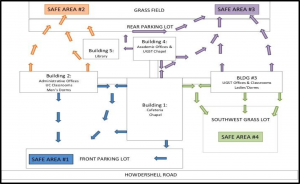Emergency Notification and Timely Warnings
During orientation of new students and faculty/staff, emergency evacuation procedures will be reviewed. Periodic emergency evacuation drills will be conducted using the procedures described below.
Emergency Response
The Dean of Students will confirm when a situation is an emergency and will initiate the appropriate notification system through Populi texting system. If necessary, he/she will also notify the Hazelwood Police Department. The verbal announcement for each emergency situation is as follows:
- In case of an earthquake faculty members will alert the individuals on their floor to move only a few steps to a nearby safe place, take cover under and hold onto a piece of heavy furniture or stand against an inside wall.
- In case of a tornado faculty members will alert the individuals on their floor to move in a quick and orderly fashion to the basement of their respective buildings.
- In case of fire faculty members will alert the individuals on their floor to evacuate in a quick and orderly fashion.
Emergency Evacuation Procedures
In the event of fire or other emergency, all faculty, staff, and students shall evacuate immediately.
- In the event of an emergency, faculty, staff, and students shall evacuate by means of the marked exit closest to your classroom. There is an emergency exit in Classroom B, an exit to the north and west of Classroom A and the Board Room, and an emergency exit to the west of the Library facility.
- In the event of a fire, faculty and staff are authorized to use portable fire extinguishers to attempt to extinguish fires before evacuating.
Critical operations shutdown procedures are not required; therefore, no faculty, staff, or students are authorized to delay evacuation for this purpose.
No employees are assigned to perform medical or rescue duties during emergency evacuation situations.
After an emergency evacuation, faculty, staff, and students are to gather in the following location(s):
- Faculty and staff: South/East corner of the boiler room
- Students: Field Please wait outside until the “all clear” sign is given to return to the building.
After an emergency evacuation, the procedure for accounting for all employees is:
- Faculty and staff: Report to Dean of Students
- Students: Roll call by Student Body President
Timely Warning
A timely warning is not the same as an emergency notification. Timely warnings are issued to students, faculty and staff when deemed necessary after a report of criminal activity if the activity is considered serious or poses a continuing threat. The timely warning is designed to prevent further occurrence of similar crimes. The Dean of Students will determine when a timely warning is necessary, and when necessary, will send a timely warning notification email to all enrolled students, faculty and staff. The Hazelwood Police Department will communicate to UGST when a crime occurs that warrants a timely warning to the UGST community.
Active Shooter Protocol
An Active Shooter is an individual actively engaged in killing or attempting to kill people in a confined and populated area; in most cases, active shooters use firearm(s) and there is no pattern or method to their selection of victims.
Active shooter situations are unpredictable and evolve quickly. Typically, the immediate deployment of law enforcement is required to stop the shooting and mitigate harm to victims.
Because active shooter situations are often over within 10 to 15 minutes, before law enforcement arrives on the scene, individuals must be prepared both mentally and physically to deal with an active shooter situation.
In the event that an active shooter is on campus, students should follow the following three options:
RUN
- Have an escape route or plan in mind.
- Visitors will follow the example of faculty, staff and students.
- If possible, help others escape.
- Leave your belongings behind.
- Remain calm and follow officers’ instructions.
- Keep your hands raised and keep them visible at all times.
- Avoid making sudden moves or grabbing the police officers.
- Do not stop the officer and ask for assistance, other emergency personnel following on will assist you.
- Provide the police with the location, number and description of shooter(s).
HIDE
- If an evacuation is not possible, find a place to hide where the active shooter is less likely to find you.
- Lock and barricade the doors by moving heavy objects, such as desks, or cabinets in front of the door.
- Move away from all windows and pull any blinds or shades.
- Hide behind something substantial.
- Remain quiet and calm.
- Silence all cellphones, radios and televisions.
- Dial 911, if possible to alert police to the active shooter’s location.
- If you cannot speak, leave the line open and allow the dispatcher to listen.
FIGHT
- Only when your life is in imminent danger, and you cannot run away or hide, taking action is the last resort.
- Do not be afraid to fight.
- Act aggressively as possible against the shooter.
- Use common items as weapons, chairs, books, fire extinguishers or other heavy items.
- Use numbers to overwhelm the attacker, but only as a last resort.


